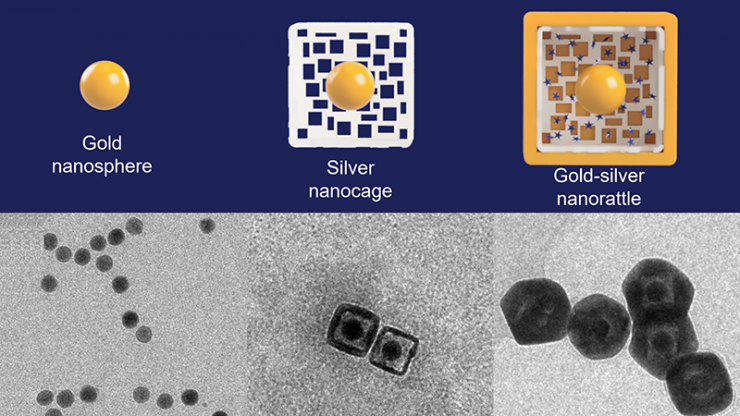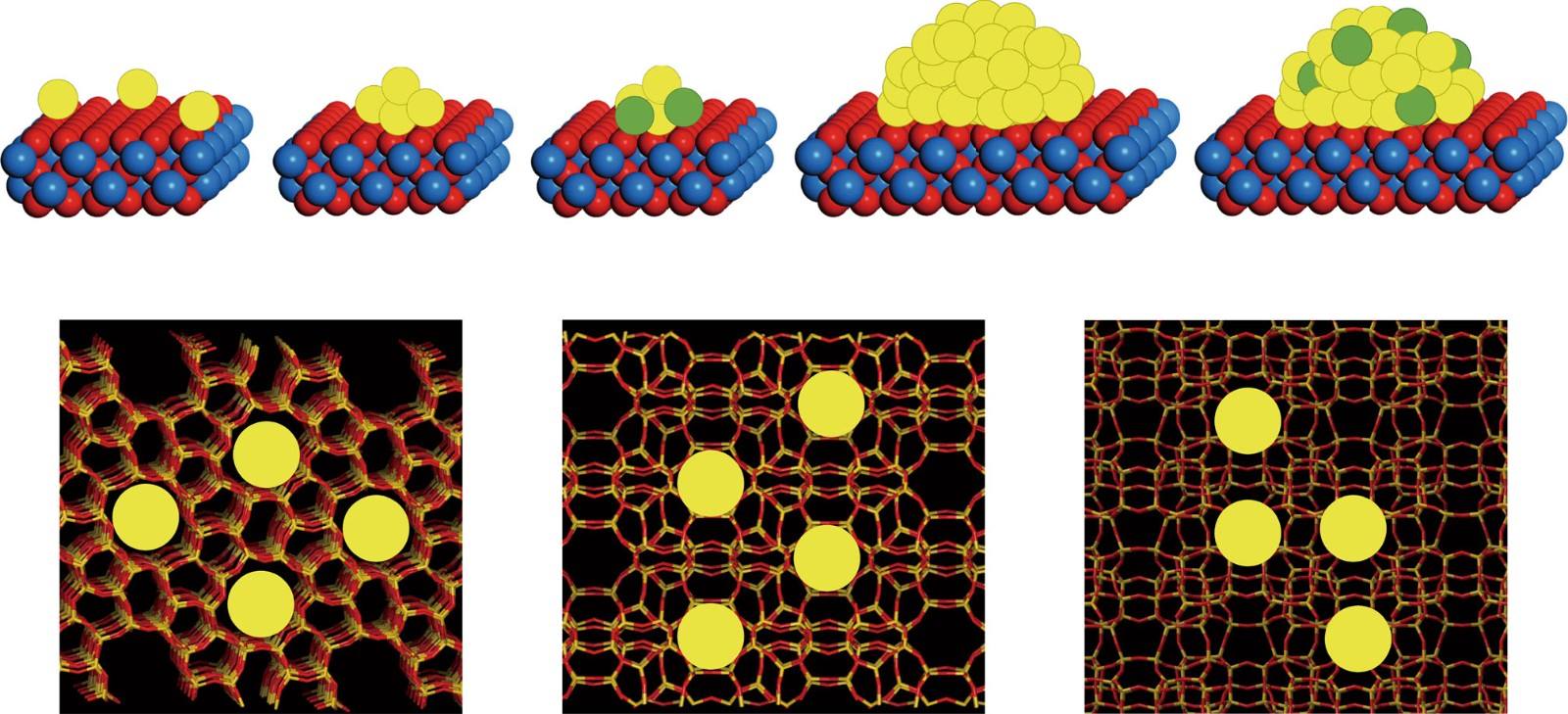创新背景
在资源匮乏的环境中,很多癌症通常出现在晚期,进而导致不好的结果。部分原因是检查设备有限,缺乏训练有素的医护人员,基本上不存在筛查项目。如果有能力在早期发现这些癌症应该会导致更早的治疗和改善结果,包括存活率和生活质量。
创新过程
研究团队开发了一种新型的探针,在内部核心和外壳之间有一个精确可调的间隙,这允许其加载多种类型的拉曼报告器,并放大它们的光发射,称为表面增强拉曼散射。
为了制造纳米炮弹,研究人员从一个约20纳米宽的纯金球体开始。在金核心周围生长一层银,形成一个更大的球体(或立方))后,他们使用一种称为电替换的腐蚀过程,将银掏空,在核心周围形成一个笼子状的外壳。然后,该结构被浸泡在含有带正电荷的拉曼报告器的溶液中,这些拉曼报告器被带负电荷的金芯吸引到外笼中。然后在外壳上覆盖一层极薄的黄金层,将拉曼报告器锁在里面。

起始的金纳米球种子(左)被一个空心的多孔银笼(中间)包围,并在金外壳内变成一个充满光散射染料的纳米瓶(右)。纳米探测器可以放大和检测来自不同类型纳米探针的信号,而无需昂贵的机器或医疗专业人员来读取结果。
其结果是一个约60纳米宽的纳米球(或纳米立方),其结构类似于响尾蛇——一个金核被困在一个更大的银-金外壳内。两者之间的距离只有几纳米,刚好能容纳拉曼报告器。这些紧密的公差对于控制纳米天线产生的拉曼信号增强至关重要。
当激光照射在纳米炮弹上时,它穿过极薄的外壳,击中里面的拉曼报告器,使它们发出自己的光。由于金核表面和金/银外壳表面的距离非常近,激光也会激发金属结构上的电子群,称为等离子体激元。由于金属核壳结构的等离子体激元相互作用,这些电子群产生了一个极其强大的电磁场,这个过程被称为等离子体耦合,它将拉曼报告器发出的光放大了数百万倍。
在这项研究中,voo - dinh和他的合作者将Nanorattle技术应用到一种能够检测头颈部癌症的棍子上实验室设备上,这种癌症出现在肩膀和大脑之间的任何部位,通常是口腔、鼻腔和喉咙。几十年来,这些癌症的存活率一直徘徊在40%到60%之间。虽然这些统计数字近年来在美国有所改善,但在资源匮乏的环境中,情况变得更糟,在那里,吸烟、饮酒和嚼槟榔等风险因素要普遍得多。
该原型装置使用了特定的基因序列,就像研究人员正在寻找的生物标志物的魔术贴一样——在这种情况下,头颈部癌症患者体内过多的特定mRNA。当有问题的信使rna出现时,它就像拴绳一样将纳米颗粒和磁珠捆绑在一起。然后,这些珠子被另一块磁铁集中并固定在原地,而其他的东西则被冲洗掉。然后,研究人员可以使用一种简单、廉价的手持设备来寻找纳米蜗牛发出的光,看看是否捕捉到了任何生物标志物。

在实验中,该测试以100%的准确性确定20个样本是否来自头颈部癌症患者。实验还表明,Nanorattle平台能够处理多种类型的纳米探针,这要感谢一种机器学习算法,它可以分离分离的信号,这意味着它们可以同时针对多种生物标记物。这是该小组目前由美国国立卫生研究院资助的项目的目标。
创新关键点
研究团队开发了一种新型的探针,在内部核心和外壳之间有一个精确可调的间隙,这允许其加载多种类型的拉曼报告器,并放大它们的光发射,称为表面增强拉曼散射。
为了制造纳米炮弹,研究人员从一个约20纳米宽的纯金球体开始。在金核心周围生长一层银,形成一个更大的球体(或立方体)后,他们使用一种称为电替换的腐蚀过程,将银掏空,在核心周围形成一个笼子状的外壳。然后,该结构被浸泡在含有带正电荷的拉曼报告器的溶液中,这些拉曼报告器被带负电荷的金芯吸引到外笼中。然后在外壳上覆盖一层极薄的黄金层,将拉曼报告器锁在里面。
创新价值
新的纳米颗粒形状可以同时大大增强来自多个独立生物标志物的信号,无需活检就能准确检测头颈部癌症,从而改善全球健康。
这种方法装载了被称为拉曼报告器的光散射染料,通常用于检测有机样品中疾病的生物标记物,它可以放大和检测来自不同类型纳米探针的信号,而不需要昂贵的机器或医疗专业人员来读取结果。
在一项小型概念验证研究中,纳米orattel通过一种人工智能支持的护理点设备准确识别头颈部癌症,这可能会彻底改变资源匮乏地区检测这些癌症和其他疾病的方式,从而改善全球健康。
创新主体
杜克大学(Duke University,简称“Duke”或“杜克”)创建于1838年,坐落于美国北卡罗来纳州(North Carolina)的达勒姆(Durham),是一所私立综合研究型大学,是美国南部的大学,也是全美最优秀的大学之一。杜克大学为全球大学高研院联盟和美国大学协会成员。
The development of "nanoparticles" could help healthcare professionals accurately identify head and neck cancers
The research team developed a new type of probe with a precisely tunable gap between the inner core and the shell, which allows it to load multiple types of Raman reporters and amplify their light emission, called surface-enhanced Raman scattering.
To make the nanoshell, the researchers started with a sphere of solid gold about 20 nanometers wide. After growing a layer of silver around the gold core to form a larger sphere (or cube), they used a corrosion process called electrical replacement to hollow out the silver and create a cage-like shell around the core. The structure was then immersed in a solution containing positively charged Raman reporters that were attracted to the outer cage by the negatively charged gold core. The shell is then covered with an extremely thin layer of gold, locking the Raman reporter inside.
The result is a nanosphere (or nanocube) about 60 nanometers wide with a structure similar to that of a rattlesnake -- a gold core trapped inside a larger silver-gold shell. The distance between the two is only a few nanometers, just enough to accommodate the Raman reporter. These tight tolerances are essential to control the Raman signal enhancement generated by the nanoantennas.
When a laser is shone on the nanoshells, it passes through the extremely thin shell and hits the Raman reporters inside, causing them to emit their own light. Because of the very close proximity between the surface of the gold core and the surface of the gold/silver shell, the laser also excites groups of electrons on the metal structure, called plasmons. Thanks to the metal-core-shell plasmon interaction, these electron groups generate an extremely powerful electromagnetic field, a process known as plasmon coupling that amplifies the light emitted by the Raman reporter by millions of times.
In this study, Voo-Dinh and his collaborators applied nanoOrattle technology to a lab device on a stick capable of detecting head and neck cancers, which appear anywhere between the shoulders and the brain, usually the mouth, nasal cavity and throat. Survival rates for these cancers have hovered between 40 and 60 percent for decades. While these statistics have improved in the United States in recent years, they have gotten worse in low-resource Settings, where risk factors such as smoking, drinking and betel nut chewing are far more prevalent.
The prototype device uses specific gene sequences, like Velcro for the biomarkers the researchers are looking for - in this case, too much of a particular mRNA in head and neck cancer patients. When the messenger RNA in question is present, it acts as a tether to bind the nanoparticles to the magnetic beads. The beads were then concentrated by another magnet and held in place while the rest was rinsed off. The researchers can then use a simple, inexpensive handheld device to look for the light emitted by the nanosnails and see if any biomarkers are captured.
In the experiment, the test determined with 100% accuracy whether 20 samples were from patients with head and neck cancer. The experiments also showed that the Nanorattle platform is able to handle multiple types of nanoprobes, thanks to a machine learning algorithm that separates separated signals, meaning they can target multiple biomarkers simultaneously. That's the goal of the team's current National Institutes of Health-funded project.
智能推荐
过量摄入乳制品增加男性前列腺癌风险
2022-07-02研究团队对北美地区超过28000名男性的饮食摄入量进行跟踪研究,分析结果显示,与每天仅摄入20.2克乳制品的男性(在所有参与者中摄入量排在最低的10%)相比,每天摄入约430克乳制品的男性(在所有参与者中摄入量排在最高的10%)患前列腺癌的风险增加了27%。
涉及学科涉及领域研究方向计算机图像分析确定了使人衰弱的肺部疾病的新亚型
2022-08-01伦敦大学学院的科学家们使用基于计算机的成像分析来识别特发性肺纤维化(IPF)患者肺部损伤的新模式,为一种以前未知的、限制生命的肺部疾病亚型提供了第一个证据。
涉及学科涉及领域研究方向临床医学理论创新 | 西式饮食通过影响pks+大肠杆菌导致结直肠癌
2022-08-17美国哈佛大学医学院的研究团队对134775名参与者进行了随访研究。研究结果表明,西式饮食通过对 pks+大肠杆菌的影响增加结直肠癌风险。这也是第一个将西式饮食与癌症中特定致病菌联系起来的研究。
涉及学科涉及领域研究方向